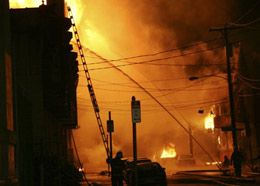 AP Photo/Rod Trautz Flames sweep through an abandoned warehouse in Philadelphia during an early morning fire in June. |
Constant injuries and deaths to firefighters occur throughout the world on an everyday basis. What the heck are we doing wrong? The answer is, “nothing” — we are doing our job the way we trained to do it.
We are doing our job following the traditions of the fire service that were instilled by the great men and women before us. It still bothers me that so much heartache and pain has to be endured and that the only question that there is no answer for is, “Who will it be next?”
Despite all the programs and great people out there — Billy Goldfeder for one — who are trying to educate us on safety, we still fail in many areas. Yes the job is dangerous, and without the commitment and determination that members of service show, we could never save lives at the rate we do.
But there are some areas from the operations side that we should be looking at — and start to really evaluate the risk versus benefit analysis. For example, do we need to put firefighters into a commercial structure that is unoccupied at 3 a.m. on a Sunday? Think about it; the only life hazard is to the firefighters.
We can assume the building is unoccupied and then develop strategy and tactics accordingly. I’m not talking about a small contents fire that could possibly be extinguished by an aggressive engine company with sufficient manpower and equipment. I am talking about a large volume of fire on arrival with possible extension to the structure itself.
No justification
You may now be scratching your heads, and saying I must be crazy or possibly even cowardly. But think of my perspective as a fireground commander. The possibility of having a member injured or killed — and for what? To save contents of a business. To me, that is not justification for exposing firefighters to unnecessary risks.
Not so long ago, we in the FDNY would think nothing of fighting a fire in a vacant building. Smart? Looking back, no.
We were in these buildings working as hard as we could to search for possible victims and to quickly extinguish the fire. But these were abandoned buildings with lots of structural damage caused by the removal of pipes and wiring by people looking to sell the scrap for cash. These were buildings with no doorways or windows and holes in the floors and roofs, buildings that had been exposed to the elements for long periods of time.
Were we ever in danger? You bet we were, almost 100 percent of the time. But we disregarded the hazards by creating our own justifications. We’d be trying to keep the fire from extending or using the building as a training ground. In essence, we were doing live-fire burns. I must stress that the commanders at the time were not purposely putting us in danger by fighting these fires — this was just the mentality of that time period concerning most structural fires.
I remember lots of times when the chief would order us out of the building, and we’d contact him via radio telling him we got the fire.
But we would ask the chief for just a couple of more minutes and we got it, never realizing the chief had a whole different perspective from his vantage point.
Additional hazards
While we would follow the normal routine of locate, confine and extinguish the fire, we’d also be careful of additional hazards that can be present in vacant buildings. However, today I would never send my troops into one of these vacant buildings unless a total risk versus benefit analysis was done, with the priority being a life hazard. I’d take the same approach when sizing-up any operation whether it is a fire or an emergency.
The point I am trying to make, and make so everyone from the young johnnie firefighter to the senior man can understand, is that our approach has to change.
Change is often difficult and tends to happen over a long period of time. But in this instance, the change needs to happen much quicker to avert the possible death of another firefighter.
Improved training and equipment in today’s fire service today has helped us to operate more safely and efficiently — but we need to take responsibility for our own safety, too.
I am a realist and know that accidents will happen from time to time, but it doesn’t mean we cannot be proactive in changing the existing culture. For this to happen, the leaders of the fire service throughout the country are the voices we need to hear, those who have always put the men and women of the fire service ahead of all other agendas.
Am I willing to step into that role? You bet I am. In the past, like all of you, I was mission oriented — get the job done at any and all costs, including the possibility of not going home to my family. But many of the chances I took as young firefighter are no longer acceptable.
I realize I could be accused here of double standards, and that this issue will be the subject of much debate in the firehouse kitchen. No doubt these conversations will be accompanied with a lot of negativity, but, I hope, with some positives as well. There will also be those fire leaders who will disagree with me, too, but when it comes down to it, I think they will ultimately take into account the safety of the brotherhood.
Finally, I would just like to take a moment to remember my brothers who made the supreme sacrifice doing their job in Charleston, South Carolina, in June You will not be forgotten — we will all make sure of that.











